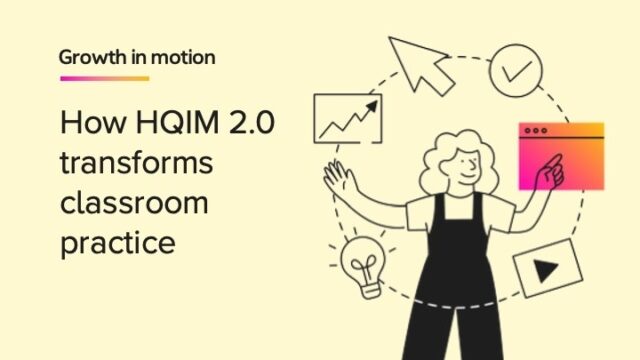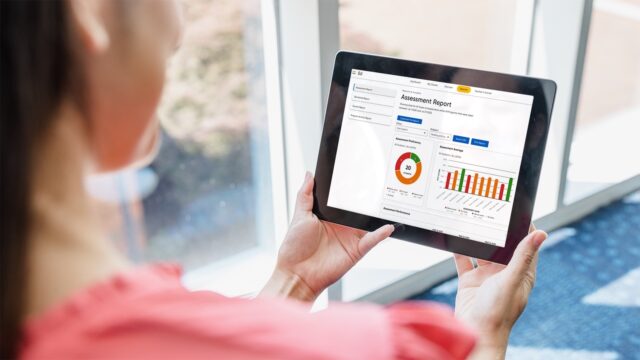
Instructional Coaching impacts students deeply. We know from a recent meta-analysis of 60 studies on the topic that it has profound effects on instruction, more than many other school-based interventions. These effects are evident regardless of educators’ experience levels. Let’s explore the two primary models of instructional coaching and provide practical insight for implementation.
Model 1: Educational Coaching Model
The educational coaching model involves a comprehensive approach that enriches the entire school system. This model encompasses a broad perspective, focusing on coaching and supporting various stakeholders. Principals, team/department leads, teachers, and district support staff can all benefit within this model. Oftentimes, districts move straight to teacher coaching, though school leaders also benefit tremendously from personalized, ongoing coaching as Eric Sheninger outlines in his article, The Case for Coaching Leaders. By partnering with multiple roles within the school or district ecosystem, a coach can notice patterns, analyze alignment to the district vision, and recognize overall trends on a wider scale.
At the Center for Model Schools (formerly ICLE), we support school districts by implementing this model for comprehensive coaching including a recent partnership with Forest Ridge School District 142 in Illinois. Our approach includes onsite coaching days and virtual calls with principals and district support staff. We co-observe classroom instruction and engage in deep conversations about how to best support all teachers in their journeys to strengthen instruction. Even at the leadership level, principals require different levels of support and focus.
Additionally, my colleague Alisa Braddy and I provide customized coaching to teachers in the form of strategy modeling and lesson feedback. Our multiple levels of support for Forest Ridge School District have created a dynamic atmosphere of energy and momentum for growth across the district.
Model 2: Teacher Coaching Model
The teacher coaching model focuses on nurturing individual excellence. It emphasizes the professional growth and instructional improvement of teachers through personalized coaching and feedback. Jim Knight highlights the transformative power of teacher coaching in his 2019 research:
“When teachers work on powerful goals that matter to them, and they partner with coaches who have a deep understanding of the strategies being learned and who provide adaptive support for professional learning when needed, research moves from being a 'nice' idea to being a central part of what happens in schools.”

Instructional coaching can take a variety of forms, though at the core of the process a teacher or team of teachers collaborate with a coach on specific needs and goals. Typically, the format is one of the following:
- Observation and feedback
- Co-planning lessons or strategies
- Modeling strategies or practices
- Guided observations
Any of these formats may be more directive or facilitative, adapting to the needs and experience levels of teachers. Newer teachers may benefit most from a more directive approach with specific guidance, while more experienced teachers may appreciate a facilitative and self-directed approach with the coach serving as a thought partner to refine practices and implement newly discovered best practices.
Let’s look at two examples of the teacher coaching model at both large- and small-scale schools. In Laramie County School District 1 in Wyoming, I have utilized multiple formats of the teacher coaching model to support schools. In some cases, a principal wanted to focus on guided observations. I collaborated with both content teams (same subject, different students) and cohort teams (same students, different subjects) to set specific focus areas. Over the course of a day, we observed each other teaching lessons in rotation. During each observation I would connect with observing teachers to point out a best practice related to their individual goal. At the end of a day of peer observations, we would debrief. We provided feedback to each other related to individual focus areas, and we set goals. Many teachers reported that this job-embedded instructional coaching was the most powerful of their career.
On a smaller scale, I collaborated virtually with ELA teachers at Whitehorse High School in San Juan School District, Utah for several years. We met regularly before school to co-plan lessons and discuss new initiatives, strategies, and resources. By taking the time to build relationships and understand each teacher’s strengths and concerns, I was able to customize our sessions, focus on their needs, and build their practice.
Implementing the Models
Whether you use the broader educational coaching model or the teacher coaching model, consider the following best practices, which I have found to support a successful implementation:
- Allow time to strengthen the educator-coach relationships. Just as students need to trust their teacher before deep learning can take place, educators need to trust their coach.
- Recognize that educators need to have choice in their goals in order to be heavily invested in the process. As Kyra Donovan shares in her journey as a principal: “Adults learn by leading their own learning with a clear purpose.”
- Reflect on the vision and goals of your district or school. Ask yourself:
- What specific areas of teaching and learning do we want to improve through coaching?
- What are the unique needs and aspirations of our educators and students?
- Consider using a growth rubric to help identify needs and set goals. You may begin by having educators self-assess according to the rubric and using that to identify specific next steps.
- Understand the coaching cycle to assist in goal setting and progress monitoring. While there are numerous explanations of the cycle, Elena Aguilar clearly outlines the process in her book The Art of Coaching. The cyclical process involves setting goals, developing action plans, reflecting on progress, and refining strategies to ensure continuous growth and improvement.
- Leverage high-quality tools such as the Rigor/Relevance framework to think through how to deepen student learning with educators. Dr. Josh Starr breaks down the framework in his blog post, Powerful Teaching with the Rigor and Relevance Framework.
Instructional coaching models have the power to expand the potential of your educators. The models foster collective teacher efficacy, which we know from John Hattie’s seminal work, Visible Learning, has an enormous effect size for student achievement. By embracing an educational coaching model that enriches the entire system or implementing a teacher coaching model to nurture individual excellence, educators can create transformative learning experiences for all.
***
Join our nationally recognized professional learning community for access to ongoing coaching and on-demand resources.
The views expressed in this article are those of the author and do not necessarily represent those of HMH.
Get the eBook Building Your School Culture: An Administrator's Guide today!














